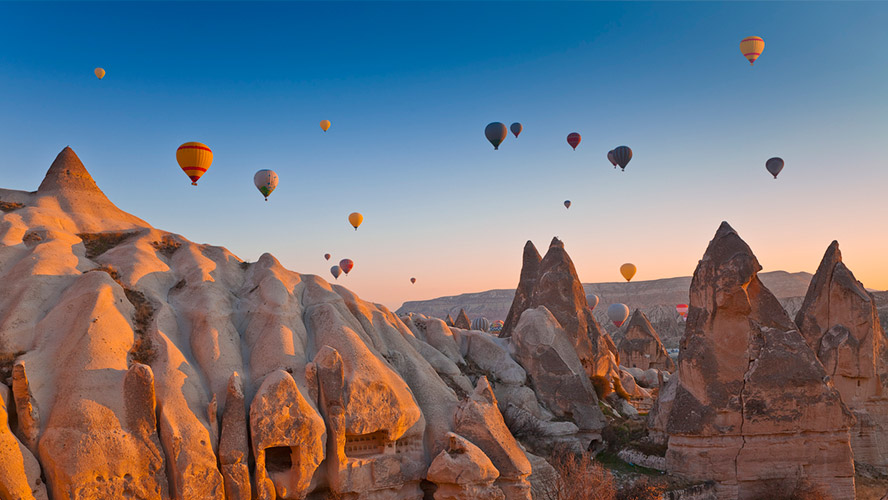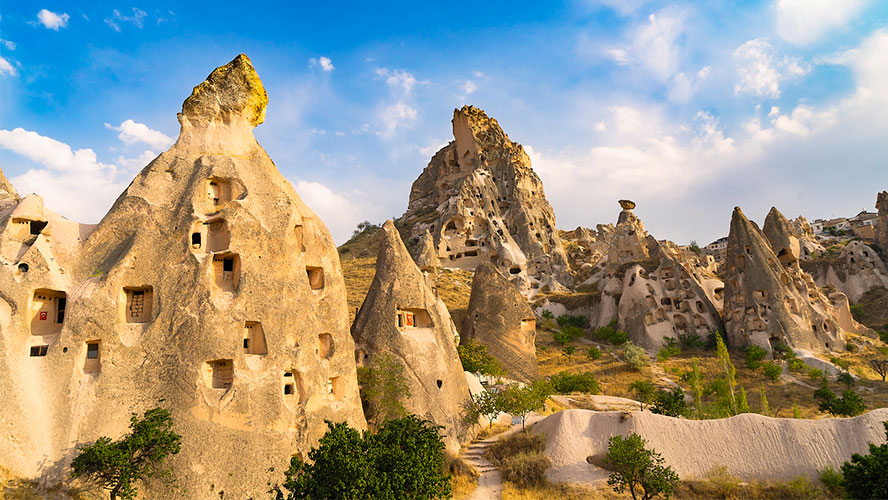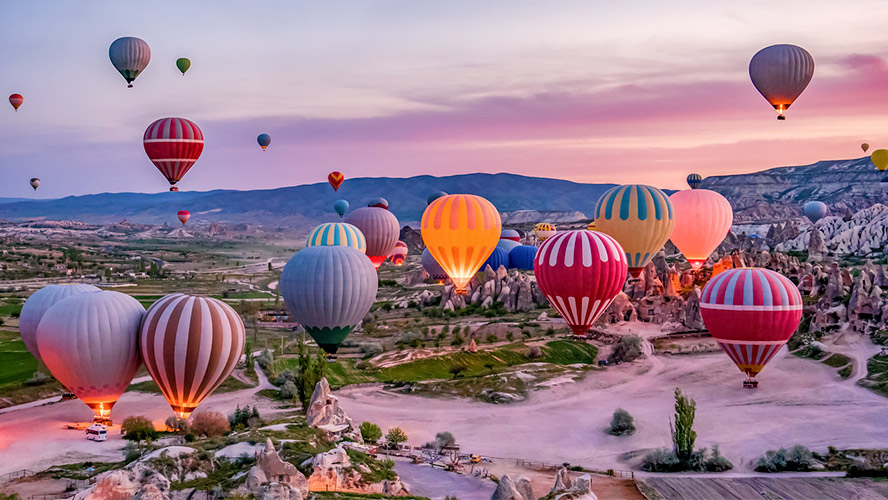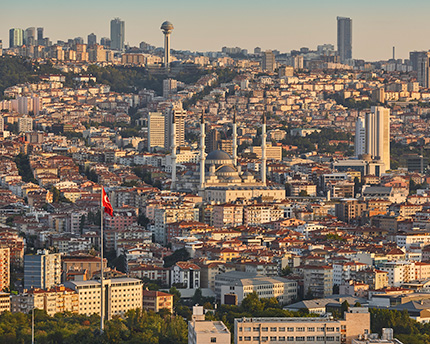In the middle of the Anatolian plateau, in the very heart of Turkey, lies this magical region whose landscapes are more reminiscent of the Moon than the Earth. It consists of whitish rock formations with vertical knife-like striations, spectacular valleys, underground cities and crags that look like they were sculpted in the beginning of time by mythical beings. This is the region of Cappadocia, which despite being fairly isolated from the rest of the country is one of Turkey’s most popular tourist destinations.
We will visit the most incredible corners of the Cappadocia region, which has been declared a UNESCO World Heritage Site. We’ll do so by land and by air, because whoever visits the region simply cannot leave without experiencing one of the most incredible activities that Turkey has to offer: discovering Cappadocia by hot-air balloon. It is guaranteed to be an unforgettable experience. Fancy joining us?
Where Cappadocia is and how to get there
First of all, it’s important to know where Cappadocia is. It is an arid location in the Central Anatolia Region, almost 800 kilometres south-east of Istanbul (and 360 kilometres from Ankara, the capital city).

There are many ways of getting to Cappadocia. Flying is unquestionably the quickest way of travelling. There are no direct flights from Spain to the city of Kayseri, where Cappadocia’s nearest airport is located (just 70 kilometres away). In light of this, your best bet is to make a stop-off in Istanbul. There are various direct flights every day which connect Istanbul’s two airports with Kayseri, with an average flight time of 1 hour and 30 minutes. When booked in advance, these flights can be very reasonably priced.
You can also get there by road, although it will take you many hours to travel the 800 kilometres separating Istanbul from Cappadocia. If you travel by bus, for example, the journey can take up to 12 hours. Despite this, Turkey’s ‘premium’ coach services tend to be very comfortable.
You could also travel by train, although the high-speed rail line only connects Istanbul to Ankara. Once you arrive in the Turkish capital, you’ll need to continue your journey by bus.
Lastly, you can always get there by car. However, this is a more expensive option and the journey is long, tediously so…
What to see in Cappadocia
Cappadocia’s history goes back precisely 10 million years. At the time, two nearby volcanoes erupted violently over a sustained period, covering the entire Central Anatolia Region with lava. The gradual action of the rain, wind and erosion sculpted the landscape of this unusual place. Humans also arrived to the area quite early on. The mythical Hittites settled there in the third millennium BC, and prosperous city-states proliferated from this early stage due to its privileged location on the trade routes between East and West. Alexander the Great set foot on this land and Imperial Rome ruled over it, with the region becoming a hotbed of different religions and creeds.

Göreme Valleys
Despite being a small farming town, Göreme is the epicentre of Cappadocia. The Göreme National Park is located just outside the town, and visitors can explore it on pleasant walks from the municipality. It is home to many surprising valleys, including Knife Valley, Pigeon Valley, Love Valley and Red Valley. The latter is home to various ancient churches that are worth visiting. Also, at the highest points of Red Valley, visitors can enjoy one of the most spectacular sunsets found anywhere in Turkey.
One kilometre from the village is the famous Open Air Museum. This museum consists of multiple ancient Byzantine churches dating from the 8th to the 11th century, which are carved out of the mountain and feature beautiful fresco paintings. If you decide to visit this museum, make sure you bring a torch.
Fairy chimneys
The famous rock formations known as ‘fairy chimneys’ are not unique to Cappadocia. However, those found in the region are possibly the most famous in the world. These are high rocky towers that are crowned with roof-like structures. These sedimentary structures have been gradually eroded over time, producing the unique shapes that we can enjoy today. The rock is more durable at the upper part of these towers and the erosion is thus more moderate, shaping the striking structures that sit atop these chimneys.
Known locally as ‘kales’ (‘castles’, in English), they can be up to 45 metres tall. The largest number of fairy chimneys are concentrated in northern Cappadocia, close to the village of Aktepe. These are the most recognisable ones, with striking pinkish tones and darker upper structures. The aforementioned Pigeon Valley, close to Göreme, is also home to some of these recognisable rock formations. In fact, the valley is so-named because the area’s pigeons nest in the upper parts of the chimneys.
Underground cities
Two of the region’s most interesting underground cities are located in the villages of Kaymakli and Derinkuyu, roughly 20 kilometres south of Göreme.
The origin of these underground constructions has been lost to time. However, it was the region’s first Christians who made systematic use of this labyrinth of tunnels and underground chambers, distributed over several levels, while fleeing persecution. The upper levels contained the dwellings and churches, while the lower levels were used for storage purposes. They had a ventilation system and even a smoke vent. This intricate set of galleries represented the perfect hiding place: even if you found the entrance, it would be tricky to find your way out.
The visit can be claustrophobic, as visitors are required to pass through low and narrow passageways.
Museums in Cappadocia
Other than the Göreme Open Air Museum mentioned earlier in this article, the province has several other interesting exhibition spaces. The two most popular museums are found in the town of Avanos, just 8 kilometres north of Göreme. The Güray Ceramics Museum is carved into the rock, 20 metres below ground level. It consists of no less than 1,600 m2 of exhibition space divided into three parts: a first part that displays archaeological ceramic pieces from the Bronze Age to the Ottoman period; a second area where pieces by the world’s most renowned contemporary ceramists are exhibited; and a third part that serves as a more conventional art gallery.
Another somewhat more bizarre museum which can be visited in Avanos is the Chez Galip Human Hair Museum. Its origins date back to 1979, when the museum’s founder split up from his lover. As a memento of the time they spent together, she gave him a lock of her hair to remember her by. Since then, the museum’s owner has collected more than 16,000 locks of hair from different women, which are now on display in this peculiar exhibition space.

Pottery, the backbone of Cappadocia’s craft industry
The Cappadocia region has managed to maintain its traditions, which are highly regarded by visitors to the area. Pottery is one of its longest-standing traditions. The town of Avanos is the nerve centre of this artisan activity. It’s not uncommon to see local potters shaping clay as you step into their shops.
In fact, it has potteries that produce some of the world’s most prized ceramic pieces. On every street corner you can buy unique and high-quality souvenirs at reasonable prices.
Uchisar Hill
This huge rock, hollowed out like a gruyère cheese, towers over the settlement of the same name, which is located just 5 kilometres outside of Göreme. It is the highest point in Cappadocia and has served as a natural castle for its inhabitants since at least the 1st century AD.
It is possible to visit the rooms of this unique castle and the galleries that connected them to each other. One of the most thrilling experiences is the climb to the top of the hill via its narrow 120-step staircase. Visitors who are brave enough to climb to the top are rewarded with one of the most spectacular panoramic views in Cappadocia – particularly if they make the ascent as the sun goes down.
Enjoy a hot-air balloon ride above Cappadocia
One of the most typical images of Cappadocia is the sight of dozens of colourful hot-air balloons floating above its unique landscape as the sun comes up. During your trip to this magical place, the icing on the cake will be the sight of the first rays of sunlight rising over this mysterious landscape at an altitude of several hundred metres.
Flights depart every morning, provided the weather conditions are favourable. Many companies offer these types of trips and outings in Göreme and Uchisar.
The gondolas, or baskets, usually have a capacity for up to 24 people. While it isn’t exactly cheap, we feel the experience is definitely worth it. It usually includes a small pre-flight breakfast and a glass of champagne after landing. The hot-air balloon ride lasts one hour. However, the entire experience, from hotel pick-up to drop-off, can take up to 3 hours.
For all those who feel the uncontrollable urge to go up in a hot-air balloon, we recommend taking something warm to wear. Also, if it makes you feel better, we suggest taking out travel insurance.










































































